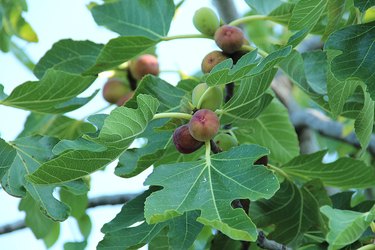
Figs (Ficus carica) are an anomaly in the plant world. While most flowering plants produce visible blossoms, fig tree flower buds are inverted, forming inside of the "fruits." The common fig produces multiple tiny flowers inside of its hollow green fruits, generally in spring. Though reliably hardy in U.S. Department of Agriculture plant hardiness zones 8 through 10, if grown in a sheltered location and mulched heavily, some cultivars may survive down to USDA zones 6 and 7.
Tip
Despite the lack of visible flowers, fig tree blossoms form in spring on new wood. In mild winter climates, some trees may produce an early crop of figs from the previous season's new growth and flower buds that developed at the end of summer.
Video of the Day
About Fig Trees
The majority of the fig cultivars found in gardens and stores, including 'Black Mission,' 'Brown Turkey,' 'Chicago Hardy' and 'Desert King,' feature self-fertile female flowers. The flowers fertilize themselves, then develop into the tiny seeds surrounded by the tasty interior of the fig fruit.
Video of the Day
The Smyrna fig cultivars, which include 'Marabout,' 'Inchàrio' and 'Zidi,' require a pollinator, the fig wasp (Agaonidae). The San Pedro fig cultivars, including 'Lampeira,' 'King' and 'San Pedro,' may produce an early unpollinated spring crop and a second wasp-pollinated crop in fall.
Common Fig Bloom Period
Because figs produce their flowers and fruits on new growth, most fig flowers bloom in spring. The fruits develop over the long hot days of summer. In addition, a number of the more than 200 fig cultivars will produce two crops in mild winter regions. The fig trees bloom again late in summer, producing flower buds that result in a spring crop of figs.
When the fruits change color to yellow, brown, reddish or purple, test for ripeness by cutting one from the branch. If it leaks white latex sap, it's not ripe yet; wait another few days and test another fig. Wear gloves and use caution as the milky sap can cause skin and eye irritation.
Fig Tree Care
These shrubby trees grow 25 feet or more tall and equally wide. Plant fig trees 25 feet apart in a full sun, well-drained location. In cool climates, plant next to a sunny, south-facing wall to create a warmer microclimate. You can also espalier fig trees against the wall to save space.
Amend the garden bed with well-decomposed compost and manure. Plant the fig at the same depth it was in the nursery pot and add stakes to support the tree. A watering basin around the tree and a 3-to-4-inch layer of mulch, pulled 6 inches from the trunk, helps keep the soil evenly moist. Fertilize with a nitrogen fertilizer in early spring, then apply diluted fish emulsion or compost tea weekly through the growing season.
Because the fruits develop on new growth, prune your fig tree in late summer, after the harvest. Potted figs can be maintained at 6 to 10 feet tall with annual pruning. Be sure to wear safety goggles, long sleeves and gloves as well as sterilizing your cutting tools in Lysol or rubbing alcohol.